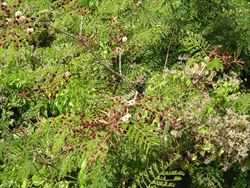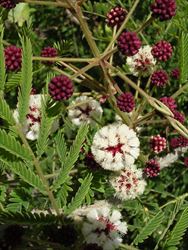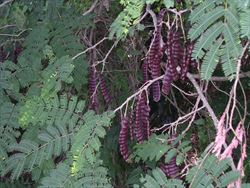- Widespread. In Australia, Fiji, PNG.
- Invasive, forming dense thickets. A shrub that grows like a vine when seeking light. Weed of sugarcane, pastures, primary and secondary forests, but also disturbed habitats, e.g., riverbanks. Threat to native species.
- Stems up to 10m long and 10cm diameter with curved thorns. Leaves, opposite, compound, 5-7 leaflets (3-7cm long), each divided into 12-18 smaller leaflets, with thorns. Flowers in clusters of 30-40 (10mm diameter) on stalks from leaf axils of upper leaves, round, cream to pale-yellow. When mature, seed pods, oblong, blackish, somewhat flattened (4.5-15cm long), with constrictions and 6-10 seeds.
- Spread: seeds by birds, animals, possibly water. Seeds used for soap/shampoo, medicines; leaves for chutneys/soups.
- Biosecurity: risk is unoffical introduction of seeds and leaves for skin/hair care and foods. Available on the Internet. Eradication attempts will require legislation (see Full Fact Sheet).
- Biocontrol: attempted but unsuccessful.
- Cultural control: hand-weed seedlings (be careful - thorns!); dig out small trees (or use heavy chains, bulldozers); clean soil and seeds from machinery/vehicles; restrict cattle from infested areas (or quarantine before moving to ‘clean’ areas); restrict movement of sand/soil.
- Chemical control: In Australia, following herbicides are registered for prickly acacia (Vachellia nilotica subsp. indica) in different situations (consult labels): fluroxypyr, triclopyr, triclopyr + picloram, fluroxypyr, hexazinome, tebuthiuron, diuron; glyphosate. In Fiji, glyphosate.










